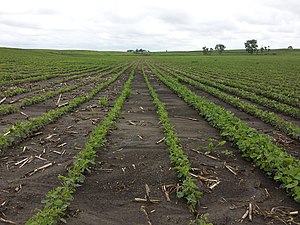
Crop rotation is the practice of growing a series of dissimilar type of crops in the same space in sequential seasons to avoid the buildup of pathogens and pests that often occurs when one species is continuously cropped. Crop rotation also seeks to balance the fertility demands of various crops to avoid excessive depletion of soil nutrients. A traditional component of crop rotation is the replenishment of nitrogen through the use of legumes in sequence with cereals and other crops. It is one component of polyculture. Crop rotation can also improve soil structure and fertility by alternating deep-rooted and shallow-rooted plants.
Crop rotation avoids a decrease in soil fertility, as growing the same crop repeatedly in the same place eventually depletes the soil of various nutrients. A crop that leaches the soil of one kind of nutrient is followed during the next growing season by a dissimilar crop that returns that nutrient to the soil or draws a different ratio of nutrients, for example, rice followed by cotton. By crop rotation farmers can keep their fields under continuous production, without the need to let them lie fallow, and reducing the need for artificial fertilizers, both of which can be expensive.
Legumes, plants of the family Fabaceae, for instance, have nodules on their roots which contain nitrogen-fixing bacteria. It therefore makes good sense agriculturally to alternate them with cereals (family Poaceae) and other plants that require nitrates. A common modern crop rotation is alternating soybeans and maize (corn). In subsistence farming, it also makes good nutritional sense to grow beans and grain at the same time in different fields.
Crop rotation is also used to control pests and diseases that can become established in the soil over time. Plants within the same taxonomic family tend to have similar pests and pathogens. By regularly changing the planting location, the pest cycles can be broken or limited. For example, Root-knot nematode is a serious problem for some plants in warm climates and sandy soils, where it slowly builds up to high levels in the soil, and can severely damage plant productivity by cutting off circulation from the plant roots. Growing a crop that is not a host for Root-knot nematode for one season greatly reduces the level of the nematode in the soil, thus making it possible to grow a susceptible crop the following season without needing soil fumigation.
Many weeds are linked to certain culture plants. With crop rotation, the weed regime is disturbed.
The choice and sequence of rotation crops depends on the nature of the soil, the climate, and precipitation which together determine the type of plants that may be cultivated. Other important aspects of farming such as crop marketing and economic variables must also be considered when choosing a crop rotation.
Crop rotation is of particular use in organic farming, where pest control and may be achieved without synthetic pesticides.
Some implementations rotate crops on a three to five basis. An exception to this is in conditions involving white rot that affects alliums and which can stay in the soil for up to ten years.
History[edit | edit source]
Crop rotation was already mentioned in the Roman literature, and referred to by great civilizations in Africa and Asia. From the end of the Middle Ages until the 20th century, the three-year rotation was practised by farmers in Europe with a rotation: rye or winter wheat, followed by spring oats or barley, then letting the soil rest (fallow) during the third stage. The fact that suitable rotations made it possible to restore or to maintain a productive soil has long been recognized by spring crops, in place of grains for human consumption.
A four-field rotation was pioneered by the Dutch and popularised by the British agriculturist Charles Townshend in the 18th century. The system (wheat, barley, turnips and clover), opened up a fodder crop and grazing crop allowing livestock to be bred year-round. The four field rotation was a key development in the British Agricultural Revolution. Crop rotation was pioneered in the USA by George Washington Carver, not only through laboratory work, but through practical promotion and education.
In the Green revolution, the practice of crop rotation gave way in some parts of the world to the practice of simply adding synthetic chemical inputs to the depleted soil, e.g. replacing organic nitrogen with ammonium nitrate or urea and restoring soil pH with lime. However, disadvantages of monoculture from the standpoint of sustainable agriculture have since become apparent.
See also[edit | edit source]
- Four-field crop rotation, a type of crop rotation used during the British Agricultural Revolution